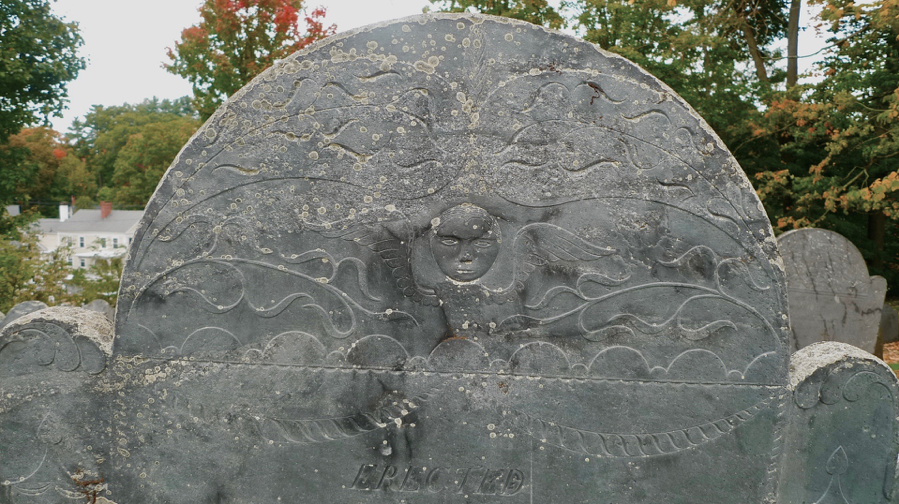All photos except the last by William Morgan
There are few better ways to spend an autumn afternoon than wandering amidst the headstones in an old New England cemetery. And some of the best old necropolises are in the historic town of Concord, west of Boston. Sleepy Hollow, the large garden cemetery with its Author's Ridge, resting place of Thoreau, Emerson and Hawthorne, is a big draw for tourists. But don’t ignore the Old Hill Burying Ground, overlooking the east end of Main Street, which has an astounding collection of carved tombstones from the 17th and 18th centuries.
Mary Minot, wife of Jonas Minot, who died at age 54.
Archibald Smith (1716-1780).
Old Hill contains some classic and noted examples of New England stone carving: seraphim, death’s heads and hourglasses that have run out of time. This is the resting place of Captain Jonathan Butterick (1690-1767). The grave says “Weep not for me’’.
Butterick, according to his stone, "lived a reputable & Useful life; in the field a good officer in ye Church a deacon." He was we can read, "not doubled-tongued; in private life a good Christian, loving husband, a kind father, a friendly neighbor." At his death, he was "followed to his grave by his aged widow & 13 well-instructed children."
Perhaps Butterick's captaincy was in the local militia, the very one that would hold the North Bridge against the King's regulars a few years later. Or perhaps he fought in one of the Indian wars.
But the quaint description of Butterick's life seems almost cozy and quaint compared to the memorial to the Concord men killed in the slaughter of the War to End All Wars, whose centennial we are now celebrating. Just across the street from Old Hill is the town's dark tribute to the carnage of modern warfare.
The seemingly straightforward recitation of the names of the 25 "Concord Men who gave their lives in the World War" provides an intriguing history lesson.
There are the usual soldiers, sailors, marines and national guardsmen, plus two deaths in the heretofore-unknown Aviation Corps. Another new wrinkle in modern killing are the members of the 1st Gas Regiment and the Gas Defence Service (given the spelling, were these two different outfits, one British?). There are medical corpsmen, quartermasters and ambulance drivers and maybe the most ancient craft represented, a farrier in the Veterinary Corps.
Being Massachusetts a century ago, there are a sprinkling of French (Gaudet, Bergeron and Bernier), Irish names (Toomey, Donovan) and Italian (Liberace and Napolitano).
Private Clemente Napolitano was in the Italian Army. Was he an immigrant drafted home, or did he go back to Italy to fight in the years before the United States entered the war? Captain Gordon M. Channel was in a Canadian light infantry regiment. Was he one of the many Americans who went north to join up to fight in Europe, not waiting for an isolationist America to confront the Hun?
The list of names tells us little more than the warriors' names and their outfits. Were that not poignant enough, Concord added the words of its own Ralph Waldo Emerson. While eloquent, the sentiment feels more high-minded Victorian, nobler than the grim reaper's cast of local boys lost in a senseless conflict, far from home.
Of course, Emerson has long been associated with Concord. Consider one of the most famous American poems, his “Concord Hymn,’’ written to commemorate the Battle of Concord (and, by extension, the Battle of Lexington, too), on April 19, 1775, at the start of the Revolutionary War. The most famous line is the fourth.
It was read and then sung at the Completion of the Battle Monument, in Concord, on July 4, 1837.
By the rude bridge that arched the flood,
Their flag to April’s breeze unfurled,
Here once the embattled farmers stood
And fired the shot heard round the world.
The foe long since in silence slept;
Alike the conqueror silent sleeps;
And Time the ruined bridge has swept
Down the dark stream which seaward creeps.
On this green bank, by this soft stream,
We set today a votive stone;
That memory may their deed redeem,
When, like our sires, our sons are gone.
Spirit, that made those heroes dare
To die, and leave their children free,
Bid Time and Nature gently spare
The shaft we raise to them and thee.
The Concord Battle Monument, next to the Concord River.
— Photo by Dave Pape
William Morgan, an essayist and architectural historian, is a frequent contributor to New England Diary on the subject of cemeteries, among other topics. He is the author of The Cape Cod Cottage, The Abrams Guide to American House Styles and Monadnock Summer, among other books.
















